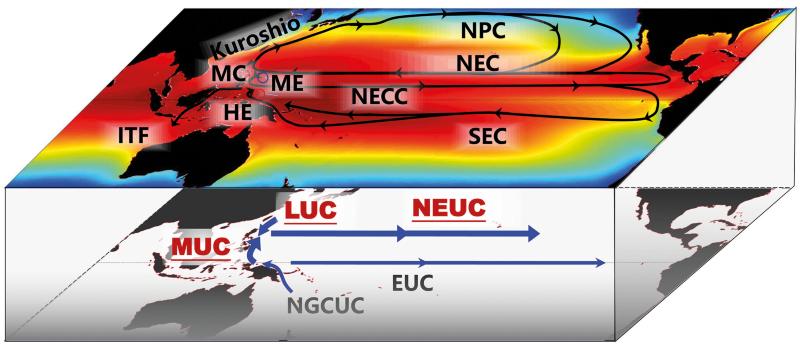IOCAS research into the fundamental forces shaping the oceans has improved our understanding of major Earth processes, from climate change, to earthquakes.

IOCAS researchers have studied how Western Pacific ocean currents and warm pools affect climate. (Image by IOCAS)
Covering about 71% of the planet, the ocean is pivotal in shaping global climate, ecosystems, and natural resource availability. Focusing on ocean circulation and geological processes in the Western Pacific, researchers at the Institute of Oceanology, Chinese Academy of Sciences (IOCAS) have been seeking to understand their environmental effects, supporting disaster prevention and resource conservation efforts.
Ocean currents are essential to global heat transport, atmosphere cycle regulation, temperature, and climate patterns. Particularly, the currents flowing along the western boundaries of the major ocean basins, known as the western boundary currents (WBCs), attract much attention, as they are more powerful, and mostly transport heat from the tropics to the polar regions. Yet, the complex Pacific WBCs, with multiple boundary currents colliding, have not been adequately studied, despite wide recognition of their importance. Researchers at IOCAS's Key Laboratory of Ocean Circulation and Waves have made WBCs a central focus.
The Pacific WBCs, associated with the largest heat and moisture supply to the atmosphere over the Pacific basin, influence processes such as the El Nino Southern Oscillation (ENSO), which severely disrupts worldwide weather patterns and creates extreme events, and the Indonesian Throughflow (ITF), which refers to the transfer of water from the Pacific to the Indian Ocean, and Asian monsoons. Due to their direct connections with seas bordering China, Pacific WBCs are crucial to China's climatic events, such as typhoon, flood, and drought.
In a Nature article published in 2015, IOCAS researchers reviewed the structure and variability of the Pacific WBCs, and evaluated their far-reaching climatic impacts. They showed that the currents move north and south simultaneously on seasonal and interannual timescales. Yet, how they are affected by global warming is unclear. IOCAS modelling of climate changes, is shedding light on the ENSO forecast, disaster control, marine environment protection, and sustainable use of marine resources.
To understand the heat and mass balances of the Pacific, and to produce a more reliable projection of Pacific WBCs and climate change, IOCAS initiated the Northwestern Pacific Ocean Circulation and Climate Experiment (NPOCE) programme to engage international collaboration.
Data-driven observations, enhanced by remote sensing, ocean system simulation and modelling, facilitate the key laboratory’s studies on ocean circulation, wave dynamics, disaster prediction and risk evaluation. IOCAS has established a comprehensive Western Pacific observation network, which is the first to cover all major current systems in the region, leading to fundamental discoveries.
Fed by more than 30 subsurface moorings, and capable of real-time data transmission at some mooring sites, this platform has enabled safe data transmission from 6,000 metres below the ocean surface, and the research has garnered intellectual property rights.
The laboratory has also been developing ocean-atmosphere coupled models for ENSO studies. One of them, the Intermediate Coupled Model (ICM) for the tropical Pacific, has been routinely used for real-time ENSO predictions. In 2015, this model was named IOCAS ICM, making sea surface temperature predictions.

